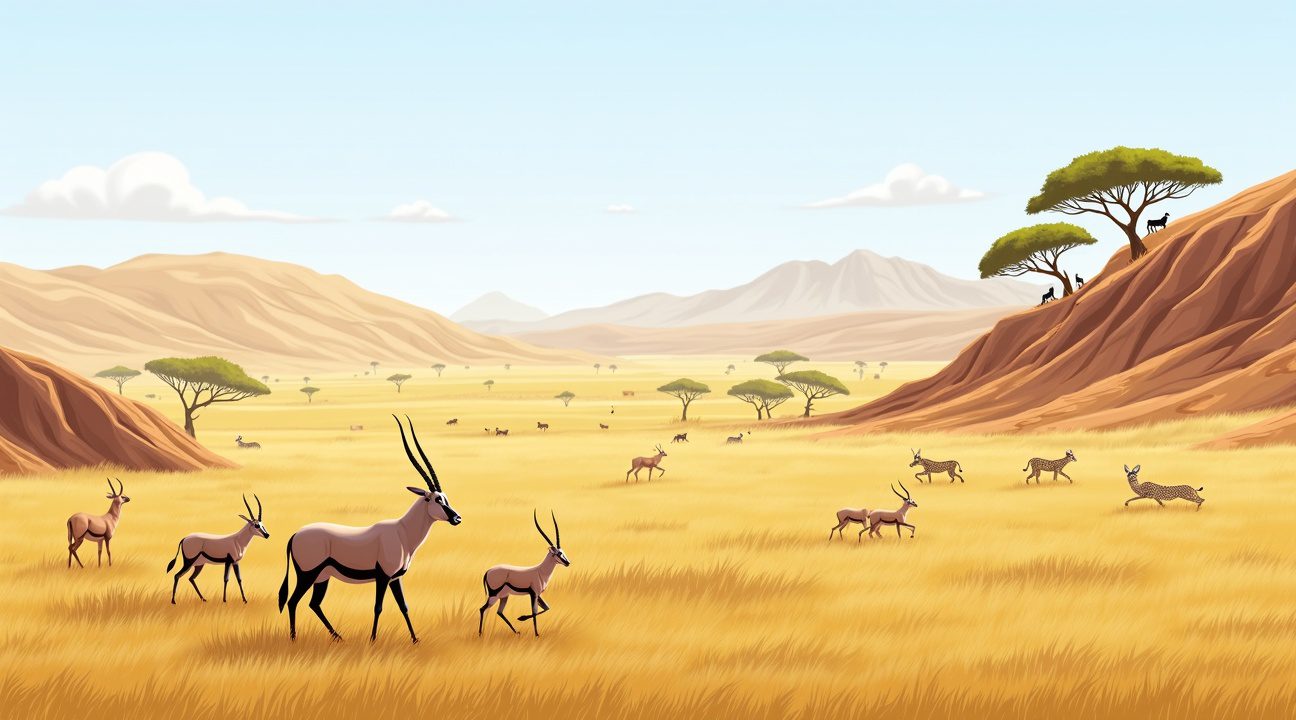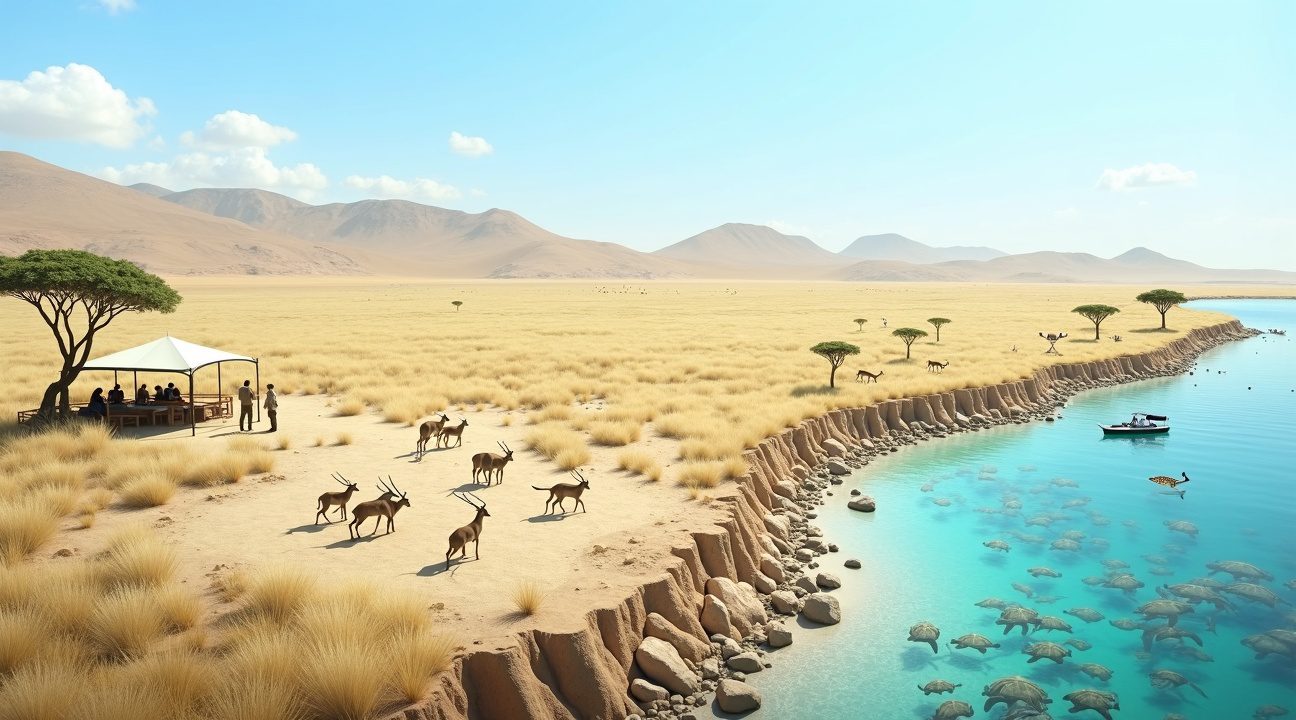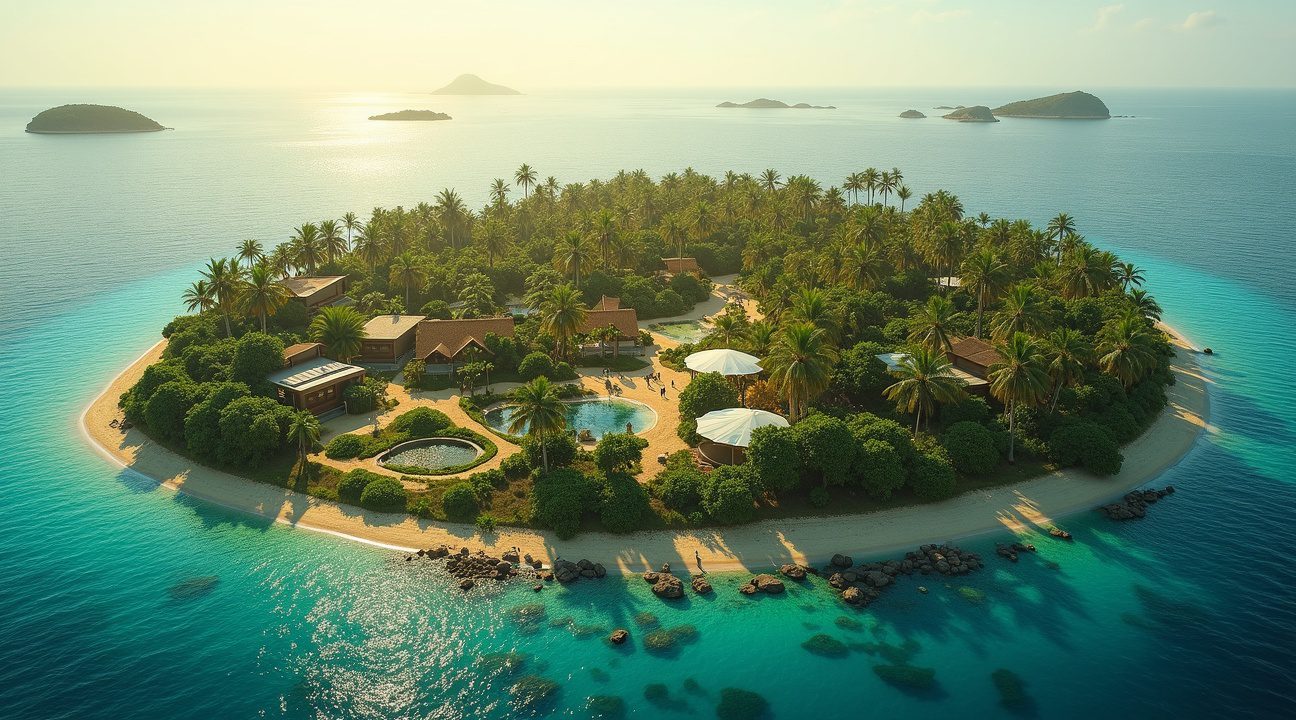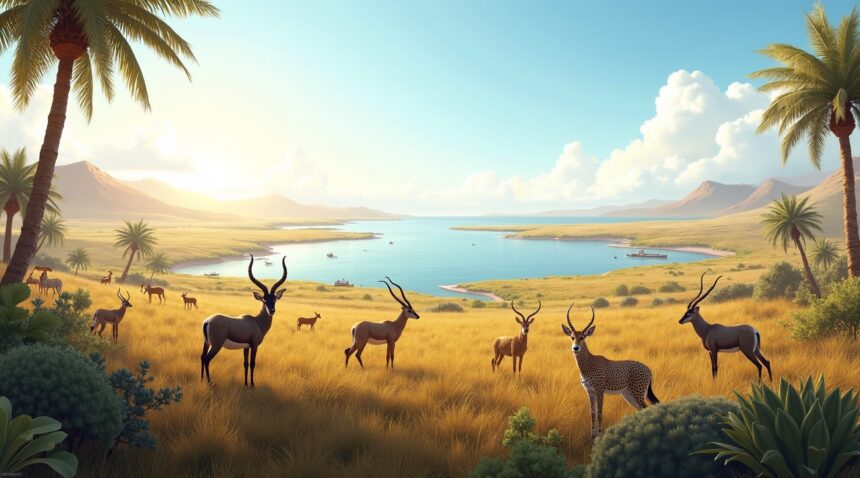Sheikh Zayed Bin Sultan Al Nahyan’s acquisition of Sir Bani Yas Island in 1971 stands as one of history’s most ambitious private conservation endeavors, converting a desert island into a flourishing sanctuary for over 11,000 endangered animals and native flora.
Key Takeaways
- Sheikh Zayed transformed Sir Bani Yas Island into a Royal Nature Reserve housing over 11,000 animals representing 30 species, including approximately 700 Arabian oryx that were once extinct in the wild.
- The conservation project follows a systematic four-phase approach: strategic animal relocation, species separation and habitat creation, predator reintroduction, and ongoing wildlife releases back to natural habitats.
- Native vegetation restoration forms the foundation of the ecosystem, supporting indigenous and migratory bird populations while creating sustainable habitat structures for all wildlife species.
- The island features an 8-kilometer marine protection zone that safeguards critical habitats for turtles, dolphins, and dugongs, demonstrating comprehensive ecosystem conservation.
- Private island conservation fills critical gaps in global wildlife protection by enabling rapid decision-making, specialized breeding programs, and complete ecosystem control that public conservation systems often cannot provide.
Sheikh Zayed’s model of conservation illustrates how private resources can be effectively used to promote biodiversity and environmental sustainability. For more information on the pioneering legacy of conservation in the UAE, learn more at the Sir Bani Yas Island official site.
Sheikh Zayed’s Revolutionary Conservation Vision: From Desert Island to Wildlife Haven
Sheikh Zayed Bin Sultan Al Nahyan transformed Sir Bani Yas Island into something extraordinary when he purchased it in 1971. Rather than developing another luxury retreat, the founding ruler of the United Arab Emirates established a Royal Nature Reserve with a clear mission: preserving Arabia’s endangered species and restoring native habitats that had been disappearing across the region.
The vision represented a radical departure from conventional private island ownership. While most wealthy individuals acquire islands for personal enjoyment or commercial development, Sheikh Zayed prioritized conservation above all else. His approach created one of the first large-scale private conservation initiatives in the Middle East, setting a precedent that few have followed since.
A Conservation Model in a Commercial World
The private island market reached USD 7.8 billion in 2024, yet the vast majority of these acquisitions focus on luxury development rather than environmental protection. Buyers typically seek pristine locations for exclusive resorts, private residences, or investment opportunities that maximize financial returns. Sheikh Zayed’s decision to dedicate Sir Bani Yas Island entirely to wildlife preservation makes it a remarkable exception in this landscape.
This conservation-first approach required significant investment without traditional monetary returns. The transformation involved:
- Importing thousands of endangered animals from across Arabia and Africa
- Establishing breeding programs for species facing extinction
- Restoring native vegetation and creating sustainable ecosystems
- Building infrastructure specifically designed to support wildlife rather than human luxury
- Training specialized staff in conservation and animal husbandry techniques
The island now hosts over 17,000 free-roaming animals representing more than 30 species, many of which were on the brink of extinction when the project began. Arabian oryx, sand gazelles, giraffes, and cheetahs now thrive in carefully managed habitats that replicate their natural environments.
Sheikh Zayed’s commitment extended beyond simply collecting rare animals. He understood that true conservation required creating sustainable ecosystems where species could reproduce naturally and maintain genetic diversity. This scientific approach involved collaboration with international wildlife experts and veterinarians who helped establish breeding protocols and habitat management strategies.
The project also addressed the broader environmental challenges facing the Arabian Peninsula. Decades of development, urbanization, and climate pressures had dramatically reduced native wildlife populations. By creating a protected sanctuary, Sheikh Zayed provided a genetic reservoir that could potentially support future reintroduction efforts across the region.
Unlike many conservation projects that struggle with funding limitations, the Royal Nature Reserve benefited from substantial financial backing and political support. This enabled long-term planning and implementation of conservation strategies that might have been impossible under different circumstances.
The island’s success demonstrates how private wealth can be leveraged for environmental benefit when conservation becomes the primary objective rather than an afterthought. Sheikh Zayed’s model proves that private island ownership doesn’t have to prioritize commercial returns or personal luxury over environmental stewardship.
Today, Sir Bani Yas Island continues operating as a conservation sanctuary while also offering limited eco-tourism opportunities. This balanced approach generates revenue to support ongoing conservation efforts while maintaining the island’s primary mission of species preservation and habitat restoration.
The legacy of Sheikh Zayed’s vision extends beyond the animals and plants he saved. His approach influenced conservation thinking across the Gulf region and demonstrated that private individuals could make meaningful contributions to global biodiversity preservation through dedicated land stewardship and scientific management practices.
Over 11,000 Animals Call This Island Home: A Biodiversity Success Story
Sir Bani Yas Island stands as a testament to what dedicated conservation efforts can achieve when resources meet vision. More than 11,000 animals representing 30 species now thrive across this transformed landscape, with many carrying the critical designation of endangered or vulnerable according to the International Union for Conservation of Nature.
The crown jewel of this conservation effort remains the Arabian oryx population, which numbers approximately 700 individuals. This achievement becomes even more remarkable when considering that this majestic species was declared extinct in the wild during the 1960s. Through careful breeding programs and habitat restoration, the island now hosts one of the world’s largest herds of these once-vanished creatures.
Species Making Their Comeback
The diversity of life returning to Sir Bani Yas extends far beyond the Arabian oryx. Sand gazelles gracefully roam the restored grasslands while blackbuck antelope, originally native to the Indian subcontinent, have found a secure refuge here. Urial sheep and barbary sheep add to the ungulate diversity, each species contributing to the complex ecosystem that’s been carefully reconstructed.
Perhaps most significantly, cheetahs have returned to UAE soil after decades of absence from the wild. These apex predators represent not just conservation success but also ecosystem restoration, as their presence indicates a healthy prey base and suitable habitat conditions. The following species have established thriving populations on the island:
- Arabian oryx – approximately 700 individuals
- Sand gazelles – adapted to arid conditions
- Blackbuck antelope – demonstrating international conservation cooperation
- Urial sheep – representing mountain-adapted wildlife
- Barbary sheep – showcasing North African biodiversity preservation
- Cheetahs – apex predators returning to their historical range
The island’s conservation programs don’t stop at providing sanctuary. Active breeding initiatives ensure genetic diversity while preparing animals for potential reintroduction to mainland habitats. This dual approach of protection and preparation creates a dynamic conservation model that benefits both island populations and broader regional biodiversity.
These numbers align impressively with other successful island conservation projects worldwide. Santa Cruz Island in California demonstrates similar potential, where fox populations recovered from fewer than 100 individuals to over 1,200 through targeted intervention. Such examples prove that islands can serve as powerful tools for species recovery when properly managed.
The scale of biodiversity achievement on Sir Bani Yas reflects broader patterns in island conservation. Research indicates that over 1,000 species of plants and animals can flourish on islands specifically managed for conservation purposes. This statistic underscores the immense potential that dedicated island sanctuaries hold for preserving Earth’s biological heritage.
What makes Sir Bani Yas particularly effective is its integration of multiple conservation strategies. Rather than focusing solely on single-species recovery, the island supports entire ecosystem restoration. This holistic approach creates sustainable habitats where various species can interact naturally, establishing the complex relationships that healthy ecosystems require.
The continuous monitoring and adaptive management practices ensure that animal populations remain healthy and genetically diverse. Scientists track breeding success, monitor habitat utilization, and adjust management strategies based on observed outcomes. This scientific approach maximizes conservation success while providing valuable data for future projects.
Beyond the immediate conservation benefits, Sir Bani Yas serves as a living laboratory for conservation techniques. The knowledge gained from managing diverse species in a controlled environment contributes to conservation science globally. Success stories like these remarkable achievements inspire similar projects worldwide, demonstrating that ambitious conservation goals can become reality with proper commitment and resources.
The island’s success validates the concept that private conservation initiatives can achieve significant biodiversity outcomes. By creating secure habitats and maintaining viable breeding populations, Sir Bani Yas has become a crucial ark for species that might otherwise face extinction, proving that conservation vision combined with substantial resources can yield extraordinary results.

Four-Phase Conservation Strategy: From Relocation to Wild Release
Sir Bani Yas Island showcases how systematic conservation phases can transform barren landscapes into thriving ecosystems. The comprehensive four-phase approach begins with strategic animal relocation, moving endangered species from vulnerable habitats to the island’s protected environment. This initial phase requires careful planning to ensure proper quarantine procedures and health assessments before introducing animals to their new home.
Species Management and Habitat Creation
The second phase focuses on separating native and non-native species to prevent ecological conflicts. Animals roam freely across nearly 87 square kilometers of protected land, creating natural habitat conditions that encourage breeding and natural behaviors. This separation strategy proves essential for maintaining genetic diversity while allowing each species to establish stable populations without interference from invasive competitors.
Predator reintroduction marks the third crucial phase, with cheetahs and other apex predators helping restore natural ecological balance. These predators control herbivore populations naturally, preventing overgrazing and maintaining vegetation health across the island’s diverse landscapes. The careful timing of predator introduction ensures prey species have established sufficient numbers to support sustainable predation cycles.
Marine Protection and Long-Term Success
A marine protection zone covering 8 kilometers of no-fishing area surrounds the island, providing critical habitats for marine species including turtles, dolphins, and dugongs. This aquatic sanctuary complements terrestrial conservation efforts by protecting breeding grounds and feeding areas essential for marine ecosystem recovery.
The final phase involves ongoing animal releases back to the wild, demonstrating the project’s ultimate success in species conservation. These releases require extensive preparation, including:
- Behavioral assessments to ensure animals retain natural instincts
- Health screenings to prevent disease transmission
- Genetic testing to maintain diverse bloodlines
- Habitat evaluation at release sites
- Long-term monitoring protocols for released populations
This ecological restoration compares favorably with the intensive Santa Cruz Island project, which involved systematic feral animal removal and resulted in remarkable species recovery. The Santa Cruz initiative saw the island fox population rebound from near extinction, while native bald eagles returned after decades of absence. Most impressively, the project removed feral pigs in just 18 months, demonstrating how systematic conservation phases can achieve rapid ecological improvements.
Wildlife reintroduction programs benefit from breeding facilities that maintain genetic diversity while preparing animals for eventual release. These programs often span multiple generations, allowing animals to develop natural behaviors essential for survival in wild environments. Successful breeding programs require specialized knowledge of each species’ reproductive cycles, dietary needs, and social structures.
Ecological restoration extends beyond animal conservation to include native plant reestablishment and habitat reconstruction. Dead vegetation removal, soil restoration, and native seed planting create the foundation for sustainable ecosystems. These efforts often take years to show results, but they provide the environmental stability necessary for long-term species survival.
Marine protection zones demonstrate how conservation strategies must address multiple ecosystem components simultaneously. Fishing restrictions allow fish populations to recover, providing food sources for marine mammals and seabirds. Coral reef protection ensures spawning grounds remain intact, supporting the entire marine food chain from microscopic organisms to large predators.
Rewilding initiatives like Sir Bani Yas Island prove that dedicated conservation efforts can reverse environmental damage and prevent species extinction. The four-phase approach provides a replicable model for other conservation projects, showing how systematic planning and long-term commitment can transform degraded landscapes into flourishing wildlife sanctuaries. These projects require substantial financial investment and scientific expertise, but they offer hope for preserving biodiversity in an increasingly threatened natural environment.

Restoring Native Flora: The Foundation of Ecosystem Balance
Native vegetation forms the backbone of any successful conservation effort, and this principle guides the comprehensive restoration work happening on protected islands worldwide. While animal rescue stories capture headlines, I’ve observed that plant restoration often determines whether conservation projects truly succeed or merely create temporary refuges.
The transformation of Sir Bani Yas Island demonstrates how strategic vegetation management creates cascading benefits throughout an ecosystem. Indigenous and migratory bird species depend entirely on habitat maintenance and vegetation protection to establish crucial breeding grounds. Without proper plant communities, even the most carefully managed animal populations struggle to thrive in artificial environments.
Santa Cruz Island provides compelling evidence of what’s possible when conservationists prioritize plant restoration alongside animal protection. The island now showcases flourishing native plants and significant re-vegetation of habitats that livestock had overgrazed for decades. This recovery didn’t happen overnight – it required systematic removal of invasive species and careful replanting of indigenous flora that had nearly disappeared.
Critical Elements of Successful Plant Community Recovery
Effective flora restoration requires specific strategies that address both immediate threats and long-term ecosystem health:
- Removal of invasive plant species that compete with native vegetation for resources and space
- Soil rehabilitation to restore natural nutrient cycles disrupted by overgrazing or human activity
- Seed collection and propagation of rare indigenous plants before they disappear entirely
- Strategic replanting that considers natural succession patterns and species relationships
- Protection of young plants from herbivores during vulnerable establishment periods
- Monitoring systems that track plant population recovery and ecosystem balance indicators
The dramatic increases in oak seedlings following eradication of introduced species on various conservation islands illustrates why plant restoration can’t be an afterthought. These young trees represent future canopy cover that will shelter countless animal species and create the complex habitat structures that mature ecosystems require.
Reforestation efforts succeed when they recreate natural plant communities rather than simply adding trees to empty landscapes. I’ve seen projects fail because they focused on fast-growing non-native species instead of slowly establishing the diverse plant assemblages that actually support wildlife populations. The patience required for proper habitat restoration often conflicts with the desire for quick visual results, but sustainable conservation demands this long-term perspective.
Endangered plants face unique challenges that make their conservation particularly urgent. Unlike animals that can relocate when threatened, plants remain anchored to specific soil conditions and microclimates. Climate change compounds these challenges by shifting temperature and precipitation patterns faster than many plant species can adapt or migrate naturally.
The dual focus on plants and animals creates whole-ecosystem resilience that benefits both conservation goals and local communities. Restored plant communities improve soil stability, reduce erosion, and enhance water retention – services that protect human settlements while supporting wildlife. Islands that have successfully restored native flora often become important research sites where scientists study ecosystem recovery and develop techniques for similar projects worldwide.
Migratory birds serve as living indicators of restoration success, arriving seasonally to use breeding grounds and feeding areas that healthy plant communities provide. Their presence signals that habitat restoration has progressed beyond simple tree planting to recreate the complex ecological relationships that sustain diverse wildlife populations. These birds also connect island conservation efforts to broader migration corridors, making local restoration work part of international conservation networks.
Modern conservation projects increasingly recognize that ecosystem balance requires attention to every level of biological organization, from soil microorganisms to apex predators. Plant restoration creates the foundation that supports this entire pyramid of life, making it perhaps the most critical component of any serious conservation effort. Success depends on understanding how different plant species interact with each other and with the animals they’re meant to support.
Private Conservation vs. Global Wildlife Protection: Filling Critical Gaps
Private conservation initiatives on islands like Sir Bani Yas represent a powerful complement to traditional public conservation systems. While the U.S. National Wildlife Refuge System operates over 570 sites, these vast networks often can’t address every conservation need with the precision and speed that private sanctuaries provide.
The numbers reveal a striking reality about conservation priorities. Only 18% of zoo animals globally are endangered, which means most public facilities focus on education and entertainment rather than critical species preservation. Private wildlife sanctuaries operate with a fundamentally different mission—they can dedicate entire ecosystems exclusively to species that face imminent extinction threats.
Strategic Advantages of Private Island Conservation
Private land conservation efforts possess unique advantages that public systems simply can’t replicate. Consider that each state in the US averages 74% private land ownership, creating enormous potential for conservation impact outside government-managed territories. Private sanctuary operators can make immediate decisions about habitat creation, species introduction, and breeding programs without bureaucratic delays that often slow public conservation efforts.
Island sanctuaries offer particular benefits for endangered species protection:
- Complete ecosystem control allows for precise habitat management tailored to specific species needs
- Isolation from human development provides natural barriers against poaching and habitat encroachment
- Controlled access enables intensive monitoring and veterinary care impossible in larger public reserves
- Rapid response capabilities allow immediate intervention when species face sudden threats
- Specialized breeding programs can focus on genetic diversity without competing priorities
Geographic gaps in public conservation networks create another compelling case for private initiatives. Many public reserves concentrate in temperate regions, leaving tropical and subtropical species underrepresented in protection efforts. Private islands in these climate zones can address specific conservation gaps that public systems haven’t prioritized or simply can’t access due to political or economic constraints.
The scale of impact from focused private conservation often exceeds what dispersed public efforts achieve for individual species. When someone dedicates an entire island ecosystem to endangered species, they create conditions for population recovery that fragmented public habitats can’t match. This concentrated approach allows for controlled breeding programs, habitat optimization, and protection strategies that produce measurable results within shorter timeframes.
Private conservation also drives innovation in wildlife protection techniques. Without public sector constraints, private sanctuary operators can experiment with new approaches to species reintroduction, habitat restoration, and conservation technology. These innovations often benefit broader conservation efforts as successful techniques spread to public systems and other private initiatives.

Sources:
Anantara – From Extinction to the Wild: A Conservation Success Story at Sir Bani Yas Island
The Nature Conservancy – Santa Cruz Island in California
World Animal Foundation – Animal Captivity Statistics You Need to Know in 2025
TotalVet – Animals in Captivity Statistics
Dataintelo – Private Island Market Research Report 2033
Wildlife Society Bulletin – A State Assessment of Private Lands Wildlife Conservation in the United States
U.S. Fish & Wildlife Service – National Wildlife Refuge System


